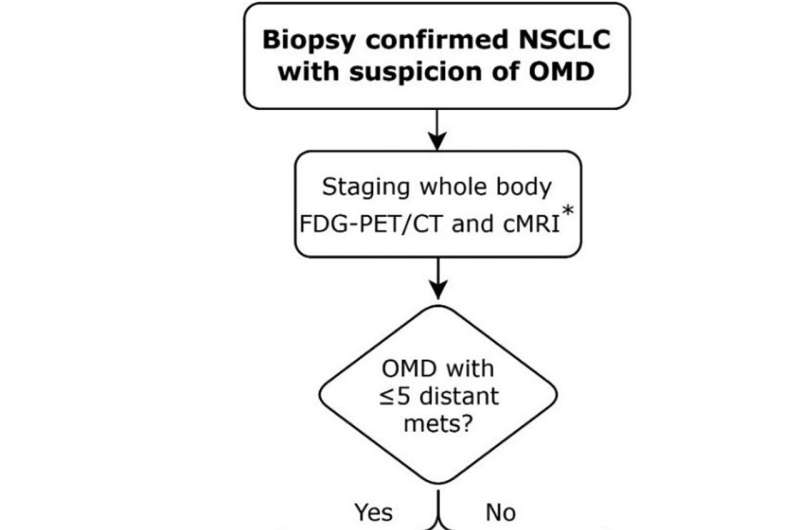
A new clinical guideline from the American Society for Radiation Oncology (ASTRO) and European Society for Radiotherapy & Oncology (ESTRO) provides guidance on the use of definitive local therapy—including radiation and surgery—to treat patients with oligometastatic non-small cell lung cancer (NSCLC). The guideline is published in Practical Radiation Oncology.
The guideline emphasizes the need for a multidisciplinary team approach to guide treatment decisions for oligometastatic disease, a description for cancer that reaches a state in which the patient has a small number of metastases in addition to a primary tumor. Treatment for oligometastatic NSCLC historically involved systemic therapy such as chemotherapy or immunotherapy, with local therapy given only for palliation and symptom relief. A growing body of research, however, points to an additional role for definitive local therapy to all disease sites, aiming at durable tumor control and improved survival outcomes.
“Oligometastatic NSCLC is a phase in lung cancer development that may offer us new opportunities to improve patient outcomes, because it typically is more treatable than widely metastatic cancer,” said Puneeth Iyengar, MD, Ph.D., co-chair of the guideline task force and an associate professor of radiation oncology at UT Southwestern Medical Center in Dallas.
“The research on local therapy for oligometastatic cancer is still at a relatively early stage, but we already see indicators of potential benefits for patients. Adding local therapy to systemic therapy may lead to more durable cancer control, potentially improving progression-free survival, overall survival and quality of life.”
“Despite the widespread enthusiasm in the field of oligometastatic disease, the quality of evidence supporting the integration of definitive local therapy into a multimodality treatment strategy is still lower as compared to indications such as locally advanced NSCLC. To compensate for this lack of highest-quality evidence, recommendations of this guideline were established by a broad consensus involving experts from ASTRO and ESTRO, colleagues from the fields of thoracic surgery and medical oncology and a patient representative,” said Matthias Guckenberger, MD, co-chair of the guideline task force and a professor and chairman of radiation oncology at the University Hospital Zurich in Switzerland.
The guideline addresses patient selection, treatment planning and delivery techniques for definitive local therapy to manage oligometastatic NSCLC, emphasizing the need for patient-centered, multidisciplinary decision-making. The guideline task force also created algorithms on the optimal clinical scenarios for local therapy and the different types of local therapy available for these patients. Key recommendations are as follows:
- The integration of definitive local therapy is recommended only for patients with five or fewer distant extracranial metastases, and only when technically feasible and clinically safe for all disease sites. Definitive local therapy in addition to standard-of-care systemic therapy is conditionally recommended for carefully selected patients with synchronous oligometastatic, metachronous oligorecurrent, induced oligopersistent or induced oligoprogressive conditions for extracranial NSCLC. These categories are explained more fully in the guideline, as well as in the ESTRO/ASTRO white paper on oligometastatic disease.
- Radiation and surgery are the only recommended modalities for definitive local treatment of oligometastatic NSCLC. Radiation is favored when multiple organ systems are being treated or when the clinical priority is to minimize breaks from systemic therapy. Surgery is favored when large tissue sampling is needed for molecular testing to guide systemic therapy. In any situation, highly conformal radiation and minimally invasive surgical techniques are strongly recommended to minimize side effects.
- The sequencing and timing for combined systemic and local therapy are addressed, with an emphasis on up-front, definitive local treatment for symptomatic metastases. For asymptomatic patients with synchronous disease, at least 3 months of standard-of-care systemic therapy is recommended before starting definitive local therapy.
- Recommendations also outline optimal staging, radiation dosing, treatment planning and delivery techniques, with a preference for hypofractionated radiation therapy or stereotactic body radiation therapy (SBRT) when appropriate. The task force notes that “the importance of appropriate imaging cannot be overstated” to diagnose oligometastatic disease, recommending that care teams consult guidelines from groups such as the National Comprehensive Cancer Network (NCCN) and the European Organization for Research and Treatment of Cancer (EORTC). Pathological confirmation of metastases is also recommended.
- The guideline also discusses the incorporation of local therapy into standard treatment paradigms for patients whose disease returns or spreads after definitive local therapy for oligometastatic NSCLC.
Intracranial metastases were not included in this guideline, given the additional complexity involved in local therapy decisions for intracranial tumors. ASTRO’s 2022 guideline for brain metastases provides guidance for these treatments, however.
The task force also emphasized the need for equitable use of these techniques, noting that “a significant effort must be taken to ensure that the decisions regarding the use of local therapies for oligometastatic NSCLC be applied equally across all patients to avoid any health disparities.”
About the guideline
The guideline was based on a systematic literature review of articles published through February 2022. The multidisciplinary ASTRO/ESTRO task force included radiation, medical and surgical oncologists, a radiation oncology resident, a pulmonologist, thoracic surgeons, a medical physicist and a patient representative. The guideline is endorsed by the Royal Australian and New Zealand College of Radiologists and the Canadian Association of Radiation Oncology.
ASTRO’s clinical guidelines are intended as tools to promote appropriately individualized, shared decision-making between physicians and patients. None should be construed as strict or superseding the appropriately informed and considered judgments of individual physicians and patients.
More information:
Puneeth Iyengar et al, Treatment of Oligometastatic Non-Small Cell Lung Cancer: An ASTRO/ESTRO Clinical Practice Guideline, Practical Radiation Oncology (2023). DOI: 10.1016/j.prro.2023.04.004
Journal information:
Practical Radiation Oncology
Source: Read Full Article
